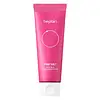What's inside
What's inside
 Key Ingredients
Key Ingredients

 Benefits
Benefits

 Concerns
Concerns

 Ingredients Side-by-side
Ingredients Side-by-side

Water
Skin ConditioningGlycerin
HumectantPotassium Stearate
CleansingPotassium Myristate
EmulsifyingPotassium Palmitate
EmulsifyingPotassium Laurate
EmulsifyingStearic Acid
CleansingMyristic Acid
CleansingPalmitic Acid
EmollientNiacinamide
SmoothingUric Acid
BufferingHibiscus Sabdariffa Flower Extract
Skin ConditioningCoco-Betaine
CleansingPolyglyceryl-3 Distearate
EmulsifyingSalicylic Acid
MaskingGlyceryl Stearate
EmollientSodium Chloride
MaskingMannitol
HumectantPolyquaternium-67
Sodium Cocoyl Alaninate
Opuntia Coccinellifera Fruit Extract
Skin ConditioningGlyceryl Stearate Citrate
EmollientMicrocrystalline Cellulose
Absorbent1,2-Hexanediol
Skin ConditioningGardenia Florida Fruit Extract
Skin ConditioningSucrose
HumectantDextrin
AbsorbentZea Mays Starch
AbsorbentHydroxypropyl Methylcellulose
Emulsion StabilisingArachidic Acid
CleansingCI 77491
Cosmetic ColorantSodium Acetate
BufferingOleic Acid
EmollientMineral Salts
Skin ConditioningSodium Hyaluronate
HumectantPanthenol
Skin ConditioningGaultheria Procumbens Leaf Extract
PerfumingCitric Acid
BufferingAllantoin
Skin ConditioningWater, Glycerin, Potassium Stearate, Potassium Myristate, Potassium Palmitate, Potassium Laurate, Stearic Acid, Myristic Acid, Palmitic Acid, Niacinamide, Uric Acid, Hibiscus Sabdariffa Flower Extract, Coco-Betaine, Polyglyceryl-3 Distearate, Salicylic Acid, Glyceryl Stearate, Sodium Chloride, Mannitol, Polyquaternium-67, Sodium Cocoyl Alaninate, Opuntia Coccinellifera Fruit Extract, Glyceryl Stearate Citrate, Microcrystalline Cellulose, 1,2-Hexanediol, Gardenia Florida Fruit Extract, Sucrose, Dextrin, Zea Mays Starch, Hydroxypropyl Methylcellulose, Arachidic Acid, CI 77491, Sodium Acetate, Oleic Acid, Mineral Salts, Sodium Hyaluronate, Panthenol, Gaultheria Procumbens Leaf Extract, Citric Acid, Allantoin
Glycerin
HumectantWater
Skin ConditioningSodium Cocoyl Glycinate
CleansingSodium Lauroyl Glutamate
1,2-Hexanediol
Skin ConditioningHydroxypropyl Starch Phosphate
Butylene Glycol
HumectantPhaseolus Radiatus Seed Powder
Lauryl Betaine
CleansingHydroxyacetophenone
AntioxidantVigna Radiata Seed Extract
Skin ConditioningEthylhexylglycerin
Skin ConditioningSodium Chloride
MaskingAlcohol
AntimicrobialBetaine
HumectantPolyquaternium-39
Melia Azadirachta Leaf Extract
Skin ConditioningMelia Azadirachta Flower Extract
Skin ConditioningDextrin
AbsorbentTheobroma Cacao Seed Extract
AntioxidantCoccinia Indica Fruit Extract
Skin ConditioningAllantoin
Skin ConditioningPhellodendron Amurense Bark Extract
Skin ConditioningAloe Barbadensis Flower Extract
EmollientSolanum Melongena Fruit Extract
Skin ConditioningSodium Benzoate
MaskingOcimum Sanctum Leaf Extract
Skin ConditioningCorallina Officinalis Extract
Skin ConditioningCurcuma Longa Root Extract
MaskingAnthemis Nobilis Flower Extract
MaskingTocopherol
AntioxidantHydrogenated Lecithin
EmulsifyingCentella Asiatica Extract
CleansingFicus Carica Fruit Extract
HumectantCeramide NP
Skin ConditioningSodium Hyaluronate
HumectantCamellia Sinensis Leaf Powder
ExfoliatingGlycerin, Water, Sodium Cocoyl Glycinate, Sodium Lauroyl Glutamate, 1,2-Hexanediol, Hydroxypropyl Starch Phosphate, Butylene Glycol, Phaseolus Radiatus Seed Powder, Lauryl Betaine, Hydroxyacetophenone, Vigna Radiata Seed Extract, Ethylhexylglycerin, Sodium Chloride, Alcohol, Betaine, Polyquaternium-39, Melia Azadirachta Leaf Extract, Melia Azadirachta Flower Extract, Dextrin, Theobroma Cacao Seed Extract, Coccinia Indica Fruit Extract, Allantoin, Phellodendron Amurense Bark Extract, Aloe Barbadensis Flower Extract, Solanum Melongena Fruit Extract, Sodium Benzoate, Ocimum Sanctum Leaf Extract, Corallina Officinalis Extract, Curcuma Longa Root Extract, Anthemis Nobilis Flower Extract, Tocopherol, Hydrogenated Lecithin, Centella Asiatica Extract, Ficus Carica Fruit Extract, Ceramide NP, Sodium Hyaluronate, Camellia Sinensis Leaf Powder
 Reviews
Reviews

Ingredients Explained
These ingredients are found in both products.
Ingredients higher up in an ingredient list are typically present in a larger amount.
1,2-Hexanediol is a synthetic liquid and another multi-functional powerhouse.
It is a:
- Humectant, drawing moisture into the skin
- Emollient, helping to soften skin
- Solvent, dispersing and stabilizing formulas
- Preservative booster, enhancing the antimicrobial activity of other preservatives
Allantoin is a soothing ingredient known for its protective and moisturizingg properties. Because of this, it is often added to products with strong active ingredients.
Studies show higher concentrations of this ingredient can promote wound healing.
Though it can be derived from the comfrey plant, allantoin is produced synthetically for cosmetic products to ensure purity.
Learn more about AllantoinDextrin is used to thicken a product and helps bind ingredients together. It is created from starch and glycogen.
As an emulsifier, dextrin prevents ingredients from separating. This helps elongate a product's shelf life.
Studies show coating UV filters with dextrin prevents these ingredients from being absorbed. This helps UV ingredients last longer on the skin.
Learn more about DextrinGlycerin is already naturally found in your skin. It helps moisturize and protect your skin.
A study from 2016 found glycerin to be more effective as a humectant than AHAs and hyaluronic acid.
As a humectant, it helps the skin stay hydrated by pulling moisture to your skin. The low molecular weight of glycerin allows it to pull moisture into the deeper layers of your skin.
Hydrated skin improves your skin barrier; Your skin barrier helps protect against irritants and bacteria.
Glycerin has also been found to have antimicrobial and antiviral properties. Due to these properties, glycerin is often used in wound and burn treatments.
In cosmetics, glycerin is usually derived from plants such as soybean or palm. However, it can also be sourced from animals, such as tallow or animal fat.
This ingredient is organic, colorless, odorless, and non-toxic.
Glycerin is the name for this ingredient in American English. British English uses Glycerol/Glycerine.
Learn more about GlycerinChances are, you eat sodium chloride every day. Sodium Chloride is also known as table salt.
This ingredient has many purposes in skincare: thickener, emulsifier, and exfoliator.
You'll most likely find this ingredient in cleansers where it is used to create a gel-like texture. As an emulsifier, it also prevents ingredients from separating.
There is much debate on whether this ingredient is comedogenic. The short answer - comedogenic ratings don't tell the whole story. Learn more about comegodenic ratings here.
The concensus about this ingredient causing acne seems to be divided. Research is needed to understand if this ingredient does cause acne.
Scrubs may use salt as the primary exfoliating ingredient.
Learn more about Sodium ChlorideSodium Hyaluronate is hyaluronic acid's salt form. It is commonly derived from the sodium salt of hyaluronic acid.
Like hyaluronic acid, it is great at holding water and acts as a humectant. This makes it a great skin hydrating ingredient.
Sodium Hyaluronate is naturally occurring in our bodies and is mostly found in eye fluid and joints.
These are some other common types of Hyaluronic Acid:
Learn more about Sodium HyaluronateWater. It's the most common cosmetic ingredient of all. You'll usually see it at the top of ingredient lists, meaning that it makes up the largest part of the product.
So why is it so popular? Water most often acts as a solvent - this means that it helps dissolve other ingredients into the formulation.
You'll also recognize water as that liquid we all need to stay alive. If you see this, drink a glass of water. Stay hydrated!
Learn more about Water